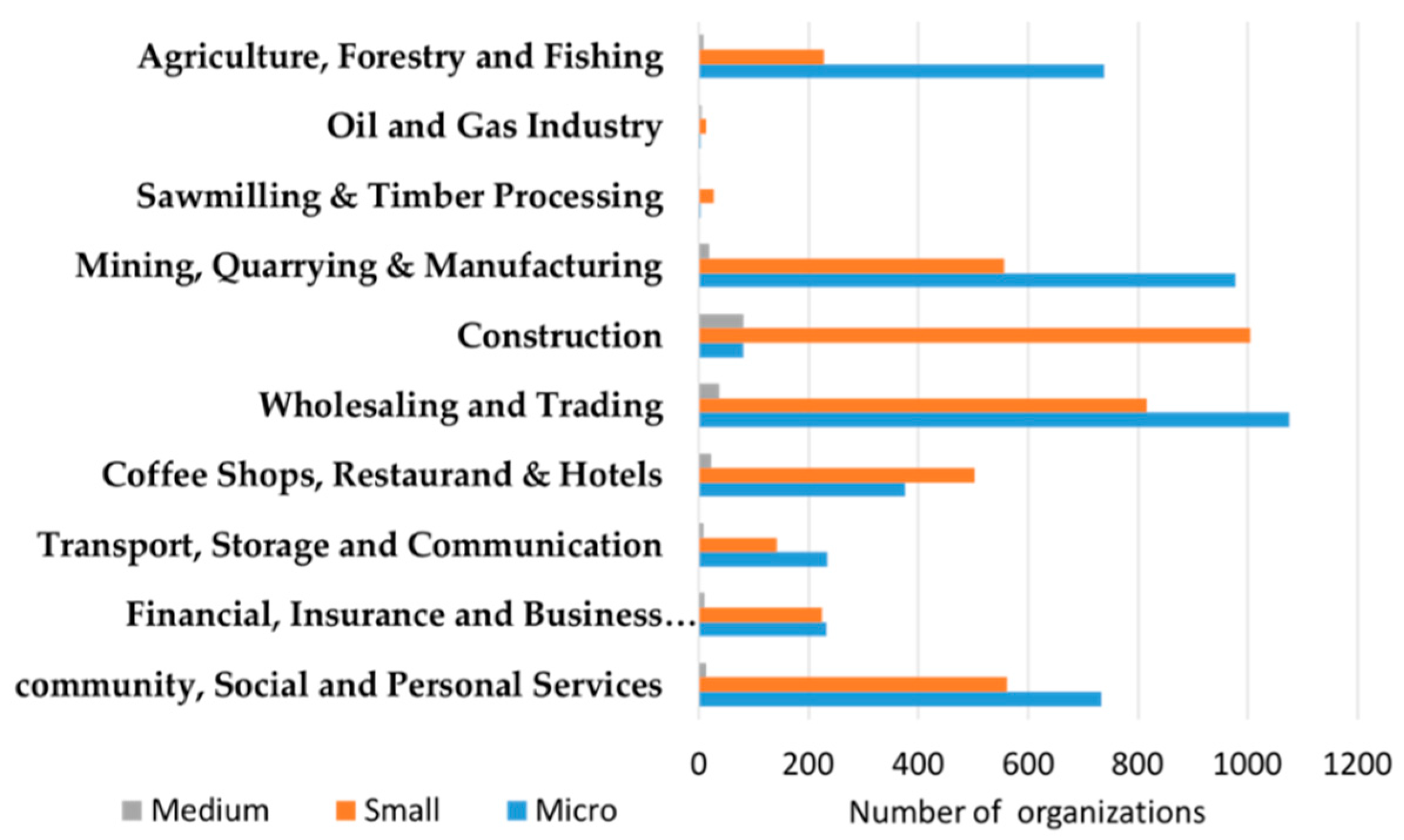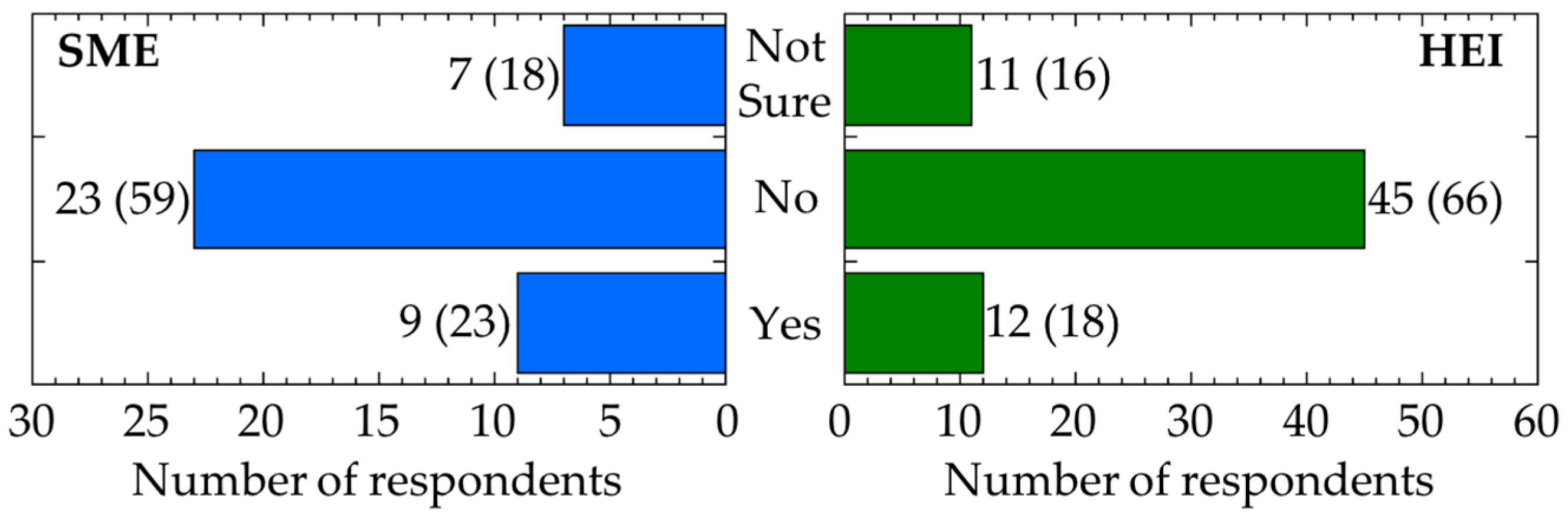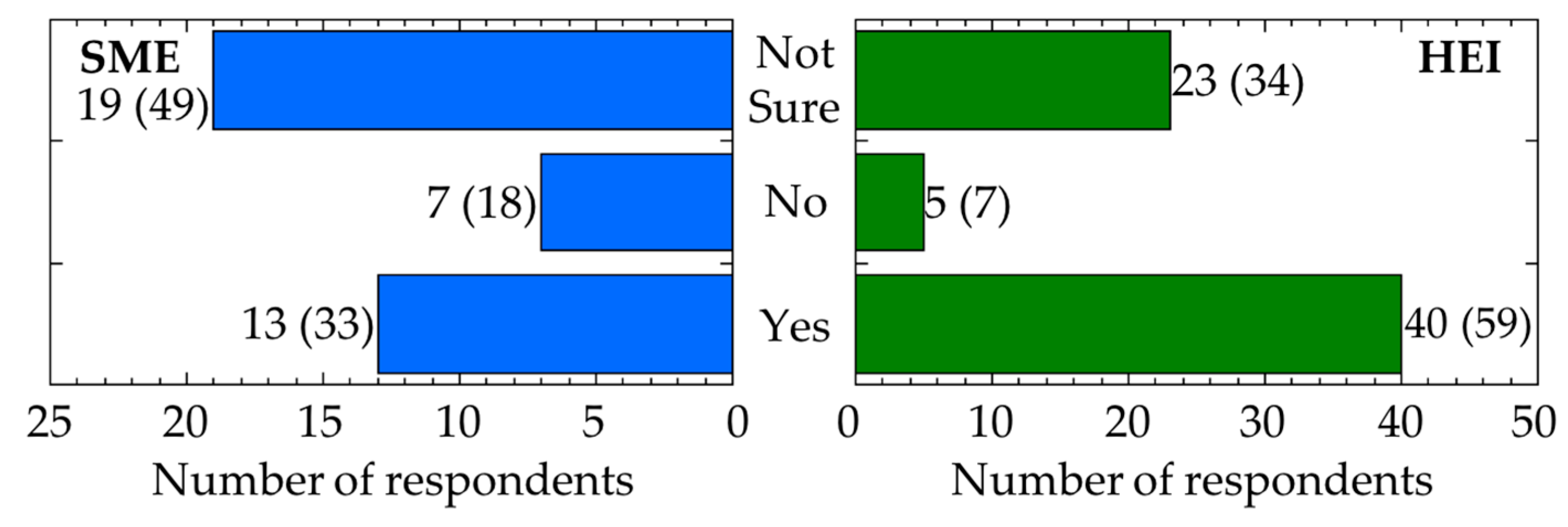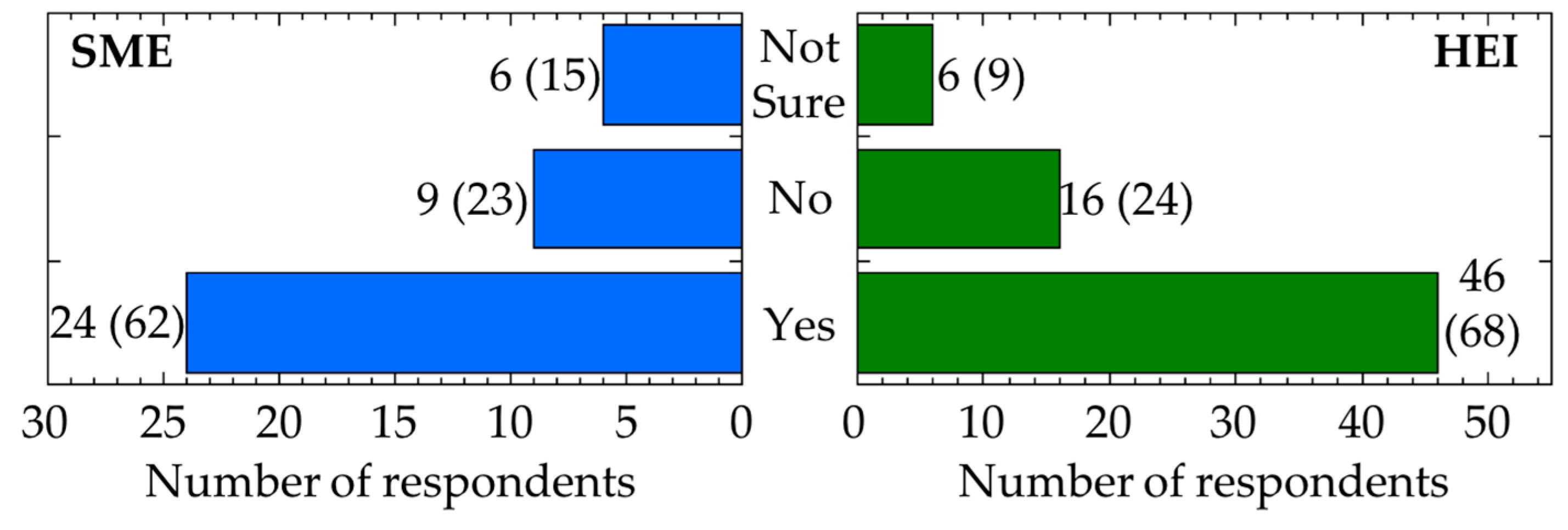1. Introduction
Successful industries and organizations depend on a culture of dynamic idea generation [
1] and management of creative individuals. Organizations seek innovative design tools and best management techniques that will optimize value of their products and services. Managing individuals to build an economically dynamic enterprise requires skills and insights that challenge norms of an organization. Consequently, practices that reduce distractions and sharpen focus of creative workforce towards organizational goals are desired. The concept of creativity, associated with chaotic dynamism [
2] at first glance, does not provide immediate support towards organizational goals. Hence, it receives passive attention and insufficient policy support necessary to foster its development even when creativity is recognized as fundamental to business success [
3]. Traditional methods of conducting businesses are not sufficient to grow Brunei Darussalam’s small and medium-sized enterprises (SMEs). Understanding, applying creative principles and processes, as well as design management strategies for the public and private industries are required. With increasing competition for survival and success, organizations cannot maintain a competitive edge by just reaching their target customers alone. Product functionality has to maintain robust design that serves current and future needs [
4]. The skill to invent a new, or transform an existing, product, services, event, or phenomenon into a marketable and thriving design has been key for strategic innovation and product development. Products and services that attract customers, sustain and captivate their interests are built on a platform of consistent evolution. Hence, industries that are not vibrant enough to continually seek cutting-edge techniques to achieve their goals and drawn customers will be left behind. Furthermore, there are challenges from a social point of view. Creative products have to provide socially useful solutions to problems. However, usefulness may not be sufficient if the novelty element is crucial, without which a product would not be creative, even though it might be valuable [
5].
In corporate environments, design managers oversee development of products and services and manage the innovation workflow. They also have significant role to play in managing the articulation of business strategy, system of product brands and service values, requiring continuous improvement for customer satisfaction [
6], and these often involve the application of design thinking, advanced technology, as well as the management of creative specialists. Csikszentmihalyi [
7] noted that creative specialists can be “both rebellious and conservative” and alternating between “smart and naivety” yet they are the driving force for the advancement of the organization. Behavioral imbalances, distractions, and inconsistences are the greater internal barriers towards optimizing creative design strategies. Therefore, identifying and applying the right creative tools to achieve the appropriate management techniques cannot be over emphasized. SMEs that stimulate and sustain a culture of creative thinking will have open innovation and continuous improvement [
8].
3. Research Methodology
The aim of this study is to determine whether the experiences and perspectives of employees in SME and students in HEI are similar. To do so, factors affecting individual and team creativity generation among employees of SMEs and students in Higher Education Institutions (HEI) in Brunei Darussalam were investigated. Prior research work discussed in the Key Literature Review section clearly identified importance of learning creativity among students and employees in organizations. Furthermore, while recognizing the inherent creativity of individuals, creative processes are enhanced by interactions in teams. At the same time, there is an overwhelming number of SMEs in Brunei Darussalam.
In light of key findings in the literature, data collection is focused on four key areas affecting students in HEI and employees of SME, namely:
Understanding and practice of creative tools and techniques;
Creativity performance in teams and as an individual; and
Perception relating to creativity.
3.1. Data Collection
Data were collected through interviews and questionnaires from SME employees involved in the product design and development process and HEI students.
Table 2 lists the job functions and level of study of HEI students.
Questions were designed to gather information on the four key areas in
Section 3. A total of 39 completed responses (
) were obtained from employees of 10 micro, five small, and five large SME. Similarly, 68 completed responses (
) were received from students enrolled in three universities and one technical institution. Students from HEIs were in their final year of study. This was done with the assumption that they have carried out at least one project during the course of their studies and so would be able to identify with the questions adequately.
Visits to SMEs were conducted to gather in-depth on state of creativity in these organizations. During these visits, interviews were conducted with employees of SMEs directly involved in product design and development. Identical questions were used, as much as possible, when interviewing all participating SMEs to ensure consistency. Interview questions were designed to gather information on overall picture of the company and interviewees responsibilities with respect to creativity, understanding of the applications of creativity and innovation in the company. More specific questions were designed to obtain information on creative tools and techniques available in the organization and how these tools are used to empower creative teams or specialists.
3.2. Data Analysis
Interviews and questionnaires conducted among employees of SME and student of HEI generated nominal data. Pearson’s chi-square
test is used to determine goodness of fit between data sets from these two groups [
36]. Pearson’s chi-square test is selected as it is not only able to determine significance between nominal data sets but it can also provide information on which categories account for differences. This advantage allows for a richer analysis of data collected. In this study, the test was implemented on Microsoft-Excel software. The Pearson Chi-square test calculates
statistic through Equation (1):
where:
| = Pearson’s chi-square statistics |
| = Number of observations of type |
| = Expected value of type |
| = Total number of observations |
For any
-type and
-atttibute combinations, the expected value
is defined by Equation (2):
where:
| = Fraction of all observations of type |
| = Fraction of all observations with attribute |
The sample sizes for employees of SME and students of HEI are 39 and 68, respectively. To determine if there is any difference between data sets of employees and students due to effects other than sample size, one of the data sets has to be linearly scaled to the sample size of the other. Scaling was done by multiplying to values in the dataset from students to map to the sample size for SME employees. Pearson’s chi-square test was implemented on transformed datasets from students. In this study, the p-value approach is used at a significance level of 0.05 adopted as a criterion. Since p-values for the chi-square statistic decrease with uniform sample size, the transformation essentially increases the likelihood of type I error.
The statistical strength of Pearson’s chi-square analyses was assessed using Cramer’s V test through Equation (3) [
37]:
where:
| = Cramer’s V test statistics |
| = Number of rows or number of columns in the contingency table, whichever is less |
5. Statistical Analysis and Discussion
Statistical analysis was performed on results presented in
Section 4. Results of the Pearson chi-square
test and Cramer’s V test for statistical strength are presented in
Table 4. The degree of freedom (Df) is defined as the number of choices of a variable less 1. For Qns A–D, there are three choices namely “Yes”, “No” and “Not sure”; hence Df is 2 for these questions. The null (
) and alternative (
) hypotheses are:
H1: Responses from employees in SME are the same as those of students in HEI.
H2: Responses from employees in SME are different as those of students in HEI.
Pearson’s chi-square
test is used to determine similarity between responses of employees in SMEs and students in HEIs. Null hypotheses are nullified if
. The p-values for Questions A and C are greater than 0.05 hence the null hypotheses are not nullifable and
is supported, as shown in
Table 4. Similarly, for Questions B, D, and E, with
,
are nullifiable and
is supported. Cramer’s V statistics for all questions are less than 0.3 which suggests weak correlation between responses of groups.
From Pearson’s chi-square analysis of response to Question A, it can be inferred that employees of SMEs and students in HEIs have similar experience in that a majority of them have not received instruction in creativity. Indeed, much more staff and students of SMEs and HEIs, respectively, do not receive instruction on creativity compared to those who do. To remedy this situation, SMEs and HEIs and can offer instruction in creativity to a wider group of employees and students in their organization. However, students and employees will respond to additional instructions in different ways as revealed by statistical analysis and responses to Question B. It indicates if additional instructions in creativity are offered, greater acceptance will be received among students of HEIs than among employees of SMEs.
Statistical analysis of Questions A and B point to the need for human resource and skill development statutory bodies such as the Darussalam Enterprise (DARE) and for educational entities in Brunei Darussalam to review their programs and curricula to ensure instructions on creativity are sufficient. A greater impact can be expected if creativity is taught at HEI as students are more interested in attending such courses. Indeed, a university that implemented creativity courses reported a total of 260 students had taken such course within four semesters [
18]. Re-invention among SMEs through initiatives to enlighten businesses on the use and application of creative design in product development is also suggested. However, since results of Question B indicate a lack of interest among employees of SMEs to attend creativity courses, regulations or incentives may be needed to compel or attract such employees to attend such courses such as through a skill-upgrading programs. As discussed in
Section 2.3, even individuals who have little prior knowledge of creative techniques can be motivated to develop novel initiatives after attending introductory creative courses [
18]. This dovetails with prior research that concludes creativity is a trait that can be learned and acquired [
1,
23]. The root cause for lack of interest among SMEs deserves further study. It is possible that a strict organizational culture, influenced by a structured societal framework, inhibits an open environment where employees can request to attend courses as indicated by prior works discussed in
Section 2.5 [
28,
29].
Employees of SMEs and students in HEIs agree that group work results in higher creative output, as shown by analysis of Question C. Additionally, the Cramer’s V statistics
is among the highest although still weak for a correlation parameter. This is important especially for HEIs which should design learning activities using greater team-based approaches especially in modules with significant creativity content. As discussed in
Section 2.4, the central idea is creativity develops from the
process. For group work, the process is facilitated through close interactions, i.e., interactions with other group members. However, individuals have to interact with his or her environment which may be prolonged and so are hindered. Hence, analysis of results of Question C reinforces findings in the literature [
10,
23,
24,
25]. This outcome is also significant as it indicates that the practice and learning of creativity is enhanced by team dynamics. Hence, HEIs should design curriculum such that team-based approaches are used in activities, especially those with creative content.
A majority of employees of SMEs and students in HEIs agree that competition will spur greater adoption of creative tools and approaches, as shown by responses to Question D shown in
Figure 5. However, Pearson’s chi-square
test show statistical difference between responses of these two groups with a
p-value of
as shown in
Table 4. An analysis of the data show that the greatest contribution to the
-value is the large difference in the proportion of those who chose “No”; 26% of SME employees and only 7% among HEI students. However, the Cramer’s V statistics
is the largest among all the questions on account of a majority in both groups choosing “Yes”; 54% of SME employees and only 78% among HEI students. Competition can be expected to stimulate improvisation necessary for innovation. It has been argued competition can have a dome-shape effect on creativity, which means it has the capacity to enact self-reliance necessary to emancipate originality and cutting-edge innovation both in industries and training institutions, but the trend of competition may also get to the extent where people will be afraid to invest both talent and capital, stifling creativity [
38]. Competition among co-workers has been observed to diminish creativity while healthy competition between groups tends to maximize potential of groups. An economy largely dominated by cultural tastes may not respond well to competition and further study exploring effect of culture on competition in Brunei is recommended.
Open-mindedness received the highest number of votes among employees of SMEs (36%) and students in HEIs (40%) as the attribute most associated with creativity as shown in
Figure 6. However, among the other four attributes, namely “Attitude”, “Insightfulnes”, “Novelty”, and “Unconventionality”, there were differences between responses of employees and students which resulted in large
value and a low
p-value of 0.037, which is below the significance level. This result is significant as prior key literature findings show that ability to suspend judgment on ideas of others is an important trait of high performance teams [
10]; as discussed in
Section 2.4. The conceptual foundations of open mindedness were developed by Hare [
39]. Open mindedness is defined as being genuinely concerned to avoid bias, wishful thinking, and other factors that tend or will compromise serious examination of evidence [
40]; it also means “being ready to view one’s conclusions, no matter how strongly supported, as completely revisable in light of further evidence given the fallible nature of knowledge claims” [
41]. These contrast to making up one’s mind in advance and that contrary views must be mistaken and, therefore, unacceptable. Open mindedness is a measure of tolerance, non-judgmental, and unbiased views. Workers can creatively perform significantly better if they understand that their views or ideas can be revised. This is especially so in light of changing or ambiguous client requirements or budget considerations which are often cited as factors that discourage a creative team as listed in
Table 3. This will give creative teams or individuals confidence needed to delve in and formulate extraordinary concepts during product development cycle. Open minded teams or individuals will seek and tap from unlimited alternatives. However, knowing alternatives depends on exposure to prior instructions in creative design and management. Hence, lack of instructions in HEIs and SMEs will discourage creative thinking. Hence, diversification programs integral to Wawasan 2035 can be better implemented in an open-minded society.
Assessing creativity is a highly intricate challenge that is virtually impossible to be accomplished using a handful of parameters, especially when attempted at the national level. An economy largely dominated by cultural tastes may not respond well to competition and further study exploring effect of culture on competition in Brunei is recommended [
42,
43]. In this context, Brunei offers a unique opportunity to study effect and interplay between culture, competition and creative processes in SMEs due to the large number of SMEs in the country. Additionally, Brunei’s culture combines Malay and Islamic tenets with strong emphasis on social order and has a culturally centralized society similar to those of other communities in East Asia, such as Chinese and Japanese societies. Culturally de-centralized countries have been reported to be more innovative than culturally centralized countries [
44].











